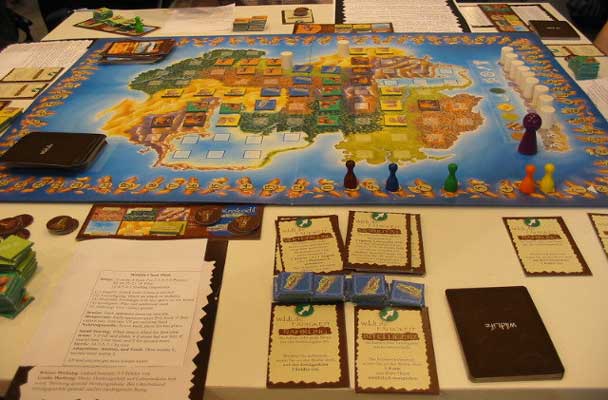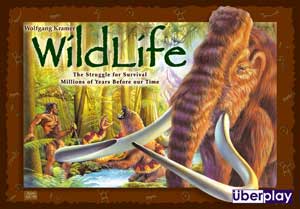Itís good to see a new game from Wolfgang Kramer on his own (heís designed quite a few games in collaboration with others over the last few years). Wildlife is published by Clementoni and was one of my surprise finds at last yearís Spiel fair (it was a surprise because I didnít expect to find a heavyweight strategy game from this company). While the Clementoni edition is in German, US publisher Uberplay is now producing an English language edition, making it more accessible to UK gamers. So I thought the time was right to review it. Essentially Wildlife is about scoring points by expanding the territory you hold by playing your cards. However, there are several ways in which points can be scored (though dominating areas on the board will probably get the most points), so itís not that simple. And players are able to expand the possible actions open to them through the game Ė cleverly, doing this scores points as well. The intricate scoring system gives plenty of scope for tactical ploys, but the basic idea is that the player with the most points at the end of the game wins. Letís start at the beginning. Inside the box is a mounted board, which shows an island divided into twelve areas Ė two each of the six different terrain types (water, desert, mountains and so on). Each area is made up of a number of spaces and the board also has the scoring tracks. There are solid cardboard playing pieces for each player, together with markers, wooden pawns and cards. Each player is a particular animal (Bear, Eagle et al) and gets the appropriate play aid and pieces for that animal. Each animal has different adaptations to the six types of terrain. Two types will be inhospitable and you can do nothing there. Two types you can move into (Migrate), one you can Expand in (or Migrate) and one you can Attack in (or Expand or Migrate). Players also get a number of Food tokens, which are the gameís currency, and a hand of ten cards. To start the game, players put some of their pieces on the board (according to the number of players and within certain limitations).  The basics of the game are that players take it in turns to play cards, adding and moving their pieces on the board. They score points when an area is fully occupied and every so often trigger a major scoring round, when players get points for having the most in various aspects of the game. A playerís turn is pretty simple: the player carries out the actions they wish in whatever order they wish. They may play up to three cards from their hand. They may move (Migrate) one of their pieces and they may convert food tokens to Victory Points (a way of scoring points, but most of the time you need food more). Then they make their hand back up to ten cards. The first wrinkle in the game is that one of the cards you play must be auctioned to the other players for food tokens. Whoever wins the auction gets the benefit of the card. This is a clever mechanism that maintains involvement during other playersí turns. It also lets players get round the limitation of the cards in their hand (by buying a card they donít have) and play out of turn. As you can see, the cards are the heart of Wildlife. There are five types of card. Terrain cards show a particular type of terrain. Playing one lets you do whatever you are adapted to do in that terrain. So, if you can Expand in it, you can add a piece to one of those areas on the board or move a piece into one of them (since Expand includes Migrate). The Attack adaptation can only be used if the area is full and allows you to replace someone elseís piece. The removed piece is out of the game, making Attack quite powerful. Adaptation cards allow you to improve your adaptation in one type of terrain by one stage. From No Action to Migrate, or from Expand to Attack, for example. Markers are provided to indicate your new adaptation and these stack up through the game. Ability cards allow you to take one of the Special Abilities, which give you additional things to do. The numbers of these are limited and, if the one you want isnít available, you take it from the player whoís got the most points at the time. (A blatant bit of handicapping, but very satisfying all the same!) Joker cards can be used as a Terrain, Adaptation or Ability card. Again, this offers a way of getting round the limitations of your hand. Finally, there are Event cards for three different events. Plague forces each opponent to lose a piece (which is out of the game). Famine means they lose food. And Food Source brings extra food tokens into the game. Another ingenious twist is that the player in last place gets some food as well as the player who played the card. Players continue taking their turns until an area is filled. The player who placed or moved the last piece into it scores some points. S/he moves an area marker off the scoring track onto the area. This shows that the area has been scored (and canít be scored again). It also shows the number of points (3-5) scored for completing the area, which goes up during the game. If it is the fourth, eighth or eleventh marker, it also triggers a full round of scoring (at the end of the playerís turn). This is where the big points are scored. First, each area is scored, points going to the player with pieces in it Ė or to the players with the most pieces. Having an area thatís full of your pieces is best (5 points). Failing that, you want to be the only person with pieces in it (4 points). Or at least the biggest (3 points)Ö Players then score for the largest herds on the board. That is, the largest groups of animals all connected together. With 10 points for the very largest herd, there are some big points available here, too. There are also points for the players with most Adaptations (count those markers on your play aid board), most Abilities and most food tokens. As you can see, there are lots of ways of scoring points. Most points will come from pieces on the board (areas and herds), but the other aspects of the game will also boost your score. The game ends when that final, eleventh scoring marker is placed or when one player plays their last piece on the board. In either case there is a final scoring round and the player with the most points wins. Simple, eh? Well, in any turn your options are limited by the cards in your hand. But you can only play a number of them, so you have some decisions to make. This gives a strong tactical element to the game: where can I make best use of which cards this turn? However you also need to keep track of the different scoring opportunities and work your way towards them. So you may have a strategic goal of maintaining a big herd while getting the most pieces in a number of areas. And I havenít mentioned those Special Abilities yet. There are five of them. The most obvious is Intelligence, which allows you to play an extra card in your turn. There are four Intelligence cards and getting one is undoubtedly a good move. There are five Food cards and one of these will give you two extra Victory Points every turn. Get these early on so that you can get the extra points for as many turns as possible. The three Mobility cards allow you to switch a piece for any other piece on the board Ė a lot faster than Migrating. There are two Defence cards, which are used to block an Attack or a Mobility move. And the sole Aggression card allows you to Attack in an area that isnít full (you still need to have the Attack adaptation in that terrain).
All in all, Wildlife is an excellent game that demands lots of decision making and some planning. Apart from the strategic element, it is full of tactical options and requires your attention throughout. I recommend it highly Ė particularly now an English language edition is available Ė and the game gets 10/10 on my highly subjective ratings scale. Wildlife is a board game designed by Wolfgang Kramer and published by Clementoni (in German) and Uberplay (in English). It is a strategy game for 2-6 players (there are special rules for a two-player game) aged 10+ and takes about 90 minutes to play. It is available in specialist games shops in the UK at around £30 (English edition).
Page created 8th April 2004. Last updated 24th June 2005. This website produced by Paul Evans. © Copyright Paul Evans 2004-2005. All trademarks acknowledged. Box art courtesy of Uberplay. Problems, comments and feedback to the Webmaster. |
Pevans |
 All of which gives players still more tactical options. However, there is an opportunity cost to everything you do. Because you can only play a limited number of cards in your turn, choosing one card to play means leaving several cards unplayed. To make sense of this you need to have some strategy Ė though thereís nothing to say that your strategy wonít change during the game.
All of which gives players still more tactical options. However, there is an opportunity cost to everything you do. Because you can only play a limited number of cards in your turn, choosing one card to play means leaving several cards unplayed. To make sense of this you need to have some strategy Ė though thereís nothing to say that your strategy wonít change during the game.